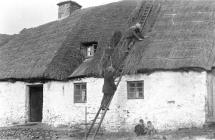The disappearance of the rural Welsh cottage
Items in this story:
Sustainable construction
Transporting materials cost money so traditional builders were expert at exploiting their local environment in a sustainable way. Cow dung, for instance, provided fertilizer for the fields, was used in the making of clay flooring, added to help bind cottage walls and also as a fire-retardant for chimneys made of woven wattle.
Earth and turf
As the poor could not afford bricks, cottage walls were built from stone, earth or timber. They used whatever they could most readily and cheaply get. In western lowland areas of Wales — Anglesey, Llŷn and west Wales — that was often earth.
Few earth cottages survive in Wales today; many more can by found in the drier areas of England. In the very wet uplands, many turf -alled cottages were built, as turf lasted much longer than earth.
Thatched roofs
Up until the development of the great slate quarries of north Wales in the 19th century, and the coming of railways, thatch was a very common material. Today, very few thatched roofed buildings survive compared to England.
Four different thatching techniques were common in Wales; only one still survives today in eastern Wales.
In west and north Wales the top coat of thatch was formed of knotted handfuls of straw thrust with a forked implement into a thick underthatch layer. The underthatch itself was often laid on a woven wattle foundation.
In the most exposed areas, the roof could be held down by a network of ropes pegged to the walltop, or held down by heavy stones.
Chimneys of straw and wattle
Cottage floors were often earth or mud. Partitions could be made of woven wattle or straw rope, covered with daub. The smoke hood above the chimney-stack was also often of daubed wattle, as was the chimney stack itself; no wonder that so many of these cottages were destroyed by fire.
But however sustainable the building materials used in these cottages, they fell prey to changes in society, and to fashion.
Changing fashions
With the growth of the Industrial Revolution, and the importation of food from abroad, more and more people left the countryside, most of them cottage dwellers.
More and more cottages, too, became the property of great estates, who began building larger homes for their workers. It was often easier to demolish the early cottages than it was to give them a second storey or to adapt them.
Today, traditional early cottages are rare survivals, and all the best remaining examples are listed as being of special architectural importance.
